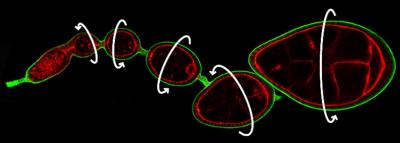


As of Beijing time The data is from a third-party organization and is only for reference.
For actual information, please refer to:www.eastmoney.com
Address: 20 Maguire Road, Suite 103, Lexington, MA 02421(America)
Tel: +1(626)986-9880
Address: Allia Future Business Centre Kings Hedges Road Cambridge CB4 2HY, UK
Tel: 0044 7790 816 954
Email: marketing@medicilon.com
Address: No.585 Chuanda Road, Pudong New Area, Shanghai (Headquarters)
Postcode: 201299
Tel: +86 (21) 5859-1500 (main line)
Fax: +86 (21) 5859-6369
© 2023 Shanghai Medicilon Inc. All rights reserved Shanghai ICP No.10216606-3
Shanghai Public Network Security File No. 31011502018888 | Website Map


Business Inquiry
Global:
Email:marketing@medicilon.com
+1(626)986-9880(U.S.)
0044 7790 816 954 (Europe)
China:
Email: marketing@medicilon.com.cn
Tel: +86 (21) 5859-1500



While the wanderings of individual cells are fairly well known, the coordinated movements of groups of cells are less familiar, even though cellular parades are of interest in diverse contexts—organ development, wound healing, and (unfortunately) metastatic cancer. To understand these collective movements, we need to do more than watch cells march to and fro. We need to listen to the drill commands that guide cells through their close-order maneuvers.

Of course, the drill commands aren’t audible or visual, they’re chemical. Two chemicals in particular, the membrane proteins Fat2 and Lar, happen to be the drill masters that allow cells to move over two-dimensional surfaces as if they were parade grounds. Such proteins have already been implicated in establishing the front-to-back orientation of individual cells, the localization of subcellular proteins, and even the transmission of long-range information across tissues. A new study, however, indicates that Fat2/Lar signaling mediates short-range communications between neighboring cells.
At the University of Chicago, cell biologist Sally Horne-Badovinac, Ph.D., and colleagues investigated how Fat2 and Lar work together to coordinate epithelial migration in the fruit fly Drosophila. The scientists presented their results March 13 in the journal Developmental Cell, in an article entitled “Fat2 and Lar Define a Basally Localized Planar Signaling System Controlling Collective Cell Migration.”
A key point from the study is that Fat2 and Lar localize to juxtaposing membrane domains and promote tissue motility by coordinating leading- and trailing-edge dynamics between neighboring cells.
“Fat2 signals from each cell’s trailing edge to induce leading edge protrusions in the cell behind, in part by stabilizing Lar’s localization in these cells,” wrote the article’s authors. “Conversely, Lar signals from each cell’s leading edge to stimulate trailing edge retraction in the cell ahead.”
As cells migrate, Fat2 signals to Lar in the cell behind it. In response, Lar signals back to Fat2, which retracts its trailing edge. Step-by-step, the neighboring cells work together in this coordinated fashion to move the entire tissue.
“The protrusion of one cell goes underneath the edge of the cell ahead, so you get what looks like overlapping shingles on a roof,” said Dr. Horne-Badovinac. “This process is understood really well at the single-cell level, but when you hook these cells all together in a tight sheet, it becomes something more coordinated.”
Dr. Horne-Badovinac’s team used a fruit fly model to study the signaling process. As female fly embryos develop, the tissues that form egg chambers elongate and rotate into position. Scientists knew that both Fat2 and Lar were involved in this process, but it wasn’t clear that cells were migrating because they were rotating around the circumference of the circular chamber, not moving in a straight line from one point to another.
Using new cell culturing techniques, the researchers could grow the egg chambers separately outside the female flies to study them more closely. They saw that when Fat2 was missing from a patch of cells with normal cells behind it, the normal cells didn’t make their usual leading-edge protrusions. If Lar was missing in a patch of cells behind a normal patch, the normal cells didn’t retract their trailing edges to move.
“It was surprising, because what we knew was that the protein [Fat2] was at the trailing edge of the cell, but we were seeing an effect at the leading edge of the cell. So initially that made absolutely no sense,” noted Dr. Horne-Badovinac. “It required careful analysis along those cloned boundaries to really figure it out.”
Dr. Horne-Badovinac still has a lot of questions about how these proteins interact with each other, and she believes that there may be other proteins involved that signal to the cytoskeletal machinery that actually drives cellular movement.
“This is just the tip of the iceberg for figuring out how this signaling system works,” she commented. “I absolutely love thinking about collective behaviors of cells, how they communicate with one another, and how groups of cells can make decisions to move in uniform in complicated ways. By studying this process in a simple Drosophila system, we might generate information that’s going to be useful for understanding wound healing or the spread of cancer.”
 Relevant
news
Relevant
news